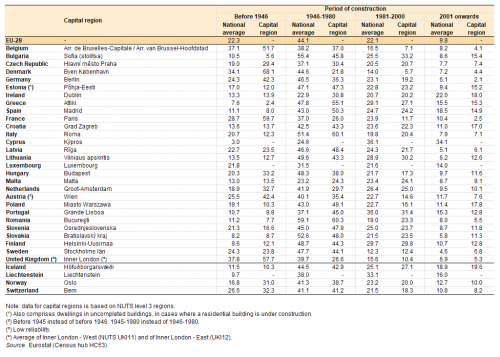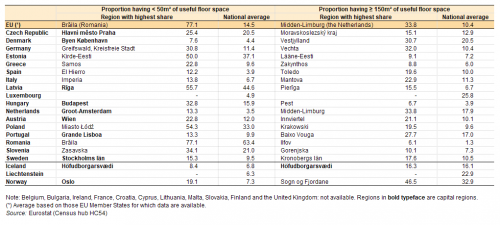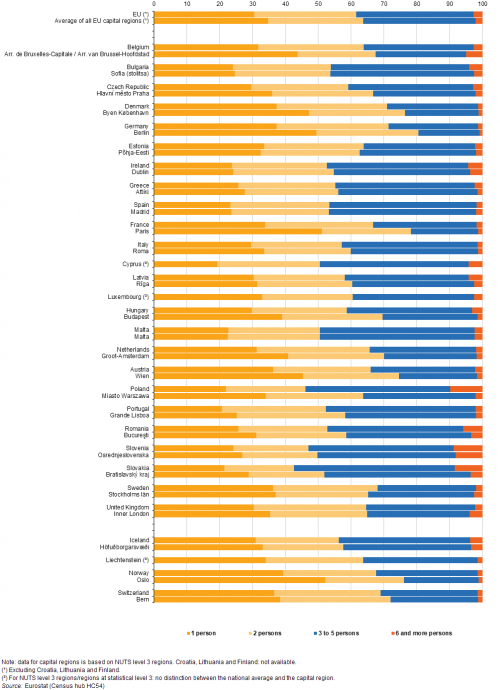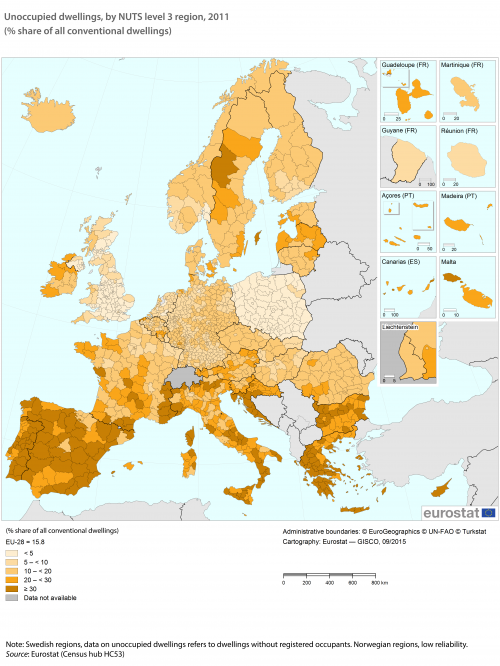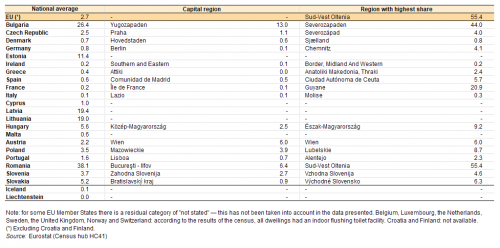Archive:People in the EU - statistics on housing conditions
Data extracted in November and December 2017
Planned update: December 2020
Highlights
Almost one in six dwellings in the EU was unoccupied in 2011.
Approximately one in three Europeans rented their home in 2016, while just over one quarter were owner-occupants with an outstanding mortgage or housing loan.
Almost 1 in 20 people across the EU faced severe housing deprivation in 2016.

(% share)
Source: Eurostat (ilc_lvho02)
This is one of a set of statistical articles that forms Eurostat’s flagship publication People in the EU: who are we and how do we live?; it presents a range of statistics that cover the characteristics of dwellings in the European Union (EU).
A paper edition of the publication was released in 2015. In late 2017, a decision was taken to update the online version of the publication (subject to data availability). Readers should note that while many of the statistical sources that have been used in People in the EU: who are we and how do we live? have been revised since its initial 2015 release, this was not the case for the population and housing census, as a census is only conducted once every 10 years across the majority of the EU Member States. As a result, the analyses presented often jump between the latest reference period — generally 2015 or 2016 — and historical values for 2011 that reflect the last time a census was conducted.
Full article
General overview
Most people spend a considerable proportion of their time at home: participating in family life, relaxing, socialising with friends, eating and sleeping, while an increasing share of the EU’s population works from home. For those who decide to buy a home, it is likely to be the single, most expensive purchase that they make during the course of their lives and for those who rent, their house/flat probably accounts for a substantial share of their monthly expenditure. Homes are highly durable and require extensive financial and material investment to build and maintain, such that owners in the EU often have a considerable amount of their personal wealth ‘locked-up’ in their property.
Looking from a wider perspective, macroeconomic developments have, in some cases, been linked to fluctuations in property markets, as witnessed when so-called ‘housing bubbles’ burst in several EU economies at the onset of the global financial and economic crisis. Demographic changes also influence housing markets: evolving family structures and an increasing proportion of elderly people will probably result in a growing number of homes being required to house a relatively unchanged number of inhabitants. For more information, please refer to an article on Changing family life — portrait of household and family structures.
Housing development and infrastructure planning are often conducted at a regional or even a national level, while more local levels of public administration often decide what can be built and where. Given the considerable investment that is required, it is often quite difficult to make rapid changes to the type and the number of houses that are made available to those looking for a new home.
Housing characteristics: the age of dwellings
A building is defined as any independent structure containing one or more dwellings covered by a roof and enclosed within external walls; a permanent building is expected to be structurally stable for a period of at least 10 years. A dwelling is a room or a suite of rooms in a permanent building designed for habitation by a private household. The most common forms of dwelling include detached houses, semi-detached or terraced houses, flats or bedsits. Dwellings should have separate access either to the road or to a communal space within a building (a staircase, corridor or passageway). Dwellings may be classified as occupied, secondary, seasonal or unoccupied. They are considered to be occupied if they provide the ‘usual place of residence’ to one or more persons.
The first section of this article is based on information from the population and housing census that was conducted in 2011. It provides an analysis of the stock of dwellings available across the EU analysed according to when they were built.
More than half of the dwellings in Bulgaria, Italy, Romania and Slovakia were built during the period 1946-1980
Table 1 presents information on the EU’s housing stock (measured in terms of numbers of dwellings) according to their period of construction, with data at a national level and information for capital regions.
Less than 1 in 10 dwellings in Finland, Slovakia, Greece and Cyprus were built before 1946. By contrast, more than one third of the housing stock in Denmark, Belgium and the United Kingdom was constructed prior to 1946. In most of the EU Member States, a considerable share of the total number of dwellings was built during the post-war period, between 1946 and 1980: some 45-50 % of the housing stock in Germany, the Baltic Member States, Greece, Hungary, Finland and Sweden was constructed during this period, a share that rose to 50-60 % in Italy, Slovakia, Bulgaria and Romania. By contrast, a handful of EU Member States experienced a period of high construction rates during the period 1981 to 2008, some of them associated with ‘housing bubbles’. These Member States— for example, Ireland, Greece, Spain, Cyprus and Portugal — are consequently characterised by a higher proportion of relatively new dwellings: at least 42 % of their dwellings were built post-1980.
There are a number of constraints that may delay or prevent the expansion of the EU’s housing stock. For example, some urban areas may already be overcrowded with a simple lack of space being a major constraint for new developments, while in suburban and rural areas, planning permission (especially for ‘greenfield sites’) may be refused. Property developers are likely to favour new constructions in those regions where they believe demand will be buoyant, while regions characterised by sluggish economic growth and less job opportunities may be characterised by lower levels of new construction.
Within the EU’s capital regions, there was a considerable variation in the age of the housing stock. More than half of all dwellings in Byen København, Paris, Inner London and Arrondissement de Bruxelles-Capitale/Arrondissement van Brussel-Hoofdstad were constructed prior to 1946, while 40-50 % of the dwellings in Sofia (stolitsa), Attiki, Vilniaus apskritis, Grande Lisboa and Helsinki-Uusimaa were built post-1980. Almost one fifth of the total housing stock in the Irish, Croatian and Polish capital regions was constructed during the period 2001 to 2011, which can be compared with less than 5 % in the Belgian, Danish, German and French capital city regions.
Post-2000, there was a rapid expansion in the number of new dwellings being constructed in Ireland, Greece, Spain, Poland and Portugal
Map 1 provides a more detailed analysis concerning the proportion of dwellings that were built after 2000 in each of the 1 315 NUTS level 3 regions of the EU. Germany accounted for more than half of the regions reporting that fewer than 5 % of their dwellings were constructed during the period 2001-2011; the majority of these regions were located in the Ruhr valley, Rheinland-Pfalz, Sachsen and Sachsen-Anhalt. There was also a relatively low level of new constructions in most Bulgarian, Baltic and Swedish regions, as well as a few regions in Italy (Piemonte, Liguria, Napoli and parts of Sicily) and the United Kingdom (the north-east of England and Wales).
There were three regions in the EU where more than one third of the total stock of dwellings was constructed during the period 2001-2011, they were: Cyprus (considered as a single region at this level of the NUTS), the autonomous Spanish city of Melilla, and the Romanian region of Ilfov, whose development is linked to the expansion of the commuter belt around the Romanian capital of Bucharest. More generally, the highest levels of new construction (as measured by the proportion of dwellings built after 2000) were registered in Irish, Greek, Spanish, Polish and Portuguese regions, while there were also pockets of high levels of recent construction activity in Bulgaria (principally in the capital region and on the Black Sea coast), France (principally western regions), Austria (around the capital region and in the Tyrol) and the United Kingdom (principally in Northern Ireland).
Housing characteristics: the average size of dwellings
The average size of dwellings across EU Member States is likely to reflect, at least to some degree, population density and housing concentration in urbanised areas, but may also reflect variations in the price of land and housing, income distribution, as well as the housing stock available for rent or for purchase. For example, in France and the United Kingdom, a relatively high share of the population lives in single family homes, while in Germany and Italy it is more common for people to live in flats.
In 2012, rural dwellings in Luxembourg and Austria were, on average, 46 m² larger than dwellings in cities
An ad-hoc module that formed part of the EU statistics on income and living conditions (EU-SILC) survey in 2012 shows that the average size of a dwelling in a rural area of the EU-28 was, on average, larger than the average size of dwellings in towns and suburbs or in cities. In 2012, dwellings in a rural area measured an average of 104.3 m², which was 5.2 m² more than in towns and suburbs, and 15.2 m² more than in cities.
The average size of dwellings in Cyprus, the Benelux countries, Denmark and Portugal was relatively large, while dwellings were often much smaller in the eastern EU Member States and the Baltic Member States. Figure 1 shows that the average size of dwellings was consistently higher in rural areas than in cities for each of the EU Member States (subject to data availability). The biggest overall differences were recorded in Luxembourg and Austria (where dwellings in rural areas were, on average, 46 m² larger than those in the cities), followed by Denmark, Germany and the Netherlands, where rural dwellings averaged 32–41 m² more area than those in cities. At the other end of the scale, there was almost no difference between the average size of dwellings in rural areas and cities in Bulgaria or Romania, as dwellings in rural areas were, on average, 1.1 m² and 3.4 m² larger than those in cities.
Information from EU-SILC confirms that living space per capita has generally increased in most EU Member States, as demographic changes have resulted in smaller household sizes, while most individuals aspire to have more space to live in.
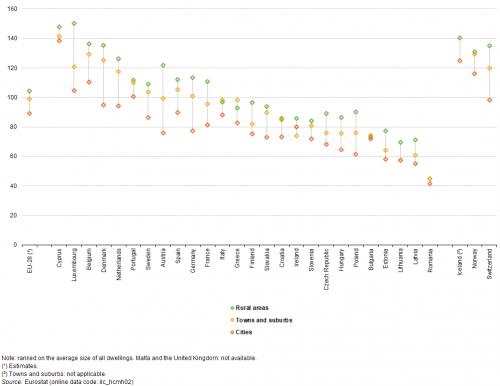
(m²)
Source: Eurostat (ilc_hcmh02)
In 2011, a majority of the dwellings in Rīga, Łódź and Brăila had less than 50 m² of useful floor space …
Useful floor space is defined as the living area available within a dwelling, as measured by floor space inside the outer walls of a building, excluding areas where people generally do not live, for example, cellars and attics, or common spaces such as foyers, corridors, lifts and stairwells in multi-dwelling buildings.
Table 2 presents information relating to the NUTS level 3 regions that exhibited the highest proportion of dwellings having less than 50 m² of useful floor space and those with the highest proportion of dwellings having at least 150 m² of useful floor space; this information is also derived from the population and housing census.
In 2011, capital regions often recorded the highest proportion of dwellings with less than 50 m² of useful floor space. This was true in the Czech Republic, Denmark, Latvia, Hungary, the Netherlands, Austria, Portugal and Sweden (note that there are 11 Member States for which data are not available at this level of detail). In some regions, a majority of dwellings provided less than 50 m² of useful floor space to their occupants: among those shown in Table 1, this was the case for the third-largest Polish city of Łódź (54.3 %), the Latvian capital of Rīga (55.7 %) and the eastern Romanian city of Brăila (77.1 %). By contrast, fewer than 1 in 10 (7.6 %) dwellings in the Danish capital of Byen København had less than 50 m² of useful floor space.
… while just over one third of the dwellings in Midden-Limburg had more than 150 m² of useful floor space
Given the premium that is often paid for living in a capital city, it is perhaps not surprising to find that none of these featured among those EU regions recording the highest proportion of their dwellings with at least 150 m² of useful floor space. Just over one third (33.8 %) of all dwellings in the Dutch region of Midden-Limburg had at least 150 m² of useful floor space, which was almost twice as high as the national average for the Netherlands (17.9 %), and was also the highest proportion in the whole of the EU across all of the NUTS level 3 regions. The proportion of dwellings with at least 150 m² of useful floor space was also relatively high — above 30 % — in the northern German region of Vechta and the western Danish region of Vestjylland. By contrast, in Estonia, Greece, Hungary and Romania every region reported that less than 10 % of its dwellings had at least 150 m² of useful floor area.
Housing characteristics: average number of occupants
In 2011, more than half of all dwellings in Paris and Oslo were occupied by single persons
Figure 2 is also based on a detailed set of data from the population and housing census relating to the average number of occupants per dwelling in the EU Member States and in each of their capital regions (based on NUTS level 3 regions). In 2011, more than one third (34.7 %) of the dwellings in EU capital regions were occupied by a single person, a share that was 4.3 percentage points higher than the average for the whole of the EU (note there are no data available for Croatia, Lithuania and Finland).
In Paris, single persons occupied over half (51.1 %) of all dwellings; this share was even higher in Oslo, reaching 52.2 % in 2011. The proportion of dwellings occupied by single persons in Paris was 17.3 percentage points higher than the average across the whole of France, which was the widest gap among those EU Member States for which data are available. There were also large differences (10 percentage points or more) in the occupancy of dwellings by single persons between capital regions and national averages in Germany, Poland and Belgium; this was also the case in Norway.
At the other end of the spectrum, the proportion of dwellings that were occupied by six or more persons was generally much lower in capital regions. This may reflect, at least in part, property developers converting large properties into multiple dwellings (bedsits, flats/and apartments), in order to meet the demand from an increasing number of people who would like to live in the EU’s capital cities. For example, almost 1 in 10 (9.9 %) dwellings across the whole of Poland were occupied by six or more persons, compared with 2.1 % of the dwellings in the Polish capital region of Miasto Warszawa. Equally, a relatively high proportion of those who move to capital cities (often for work) tend to be relatively young and may initially live alone upon arriving in a new city. After a few years, they might decide to move house having met people with whom to share or a partner with whom they would like to start a family/living together. As life progresses, it is relatively common for people to settle down and look for alternative accommodation and/or lifestyle changes, which may lead to them moving out of the capital city to suburban areas (or even further afield). There were, however, four EU Member States where the national average for the proportion of dwellings occupied by six or more persons was below that recorded for the capital region; this was the case in Spain, Sweden, the United Kingdom and Belgium.
For more information on the mobility of the EU’s population during the 12-month period prior to the population and housing census in 2011, refer to an article on Changing places — geographic mobility.
Housing characteristics: unoccupied dwellings
There are many regions in the EU that suffer from a shortage of housing and this problem will probably become exacerbated as a result of increased demand for single and two-person dwellings as family units continue to fragment. As a result, policymakers are increasingly turning their attention to unused properties, with the goal of freeing these up for use.
Occupancy statistics from the population and housing census refer to whether or not a dwelling was occupied by its ‘usual’ resident. Dwellings are therefore classified as being unoccupied if they are reserved for seasonal or secondary use (such as holiday homes) or if they are vacant (dwellings which may be for sale, for rent, for demolition, or simply lying empty and unused).
Almost one in six dwellings in the EU was unoccupied in 2011
Map 2 presents further information from the population and housing census for the proportion of conventional dwellings that stood unoccupied in each of the 1 315 NUTS level 3 regions of the EU in 2011. On average, 15.8 % of the dwellings across the whole of the EU-28 remained unoccupied. The vast majority of regions with fewer than 5 % of their dwellings unoccupied were located in Poland (every region had a share of less than 5 % except for the north-eastern region of Łomżyński) or the United Kingdom, with the only other regions being Bremen and Hamburg (both in Germany), and five Dutch regions (Noordoost-Noord-Brabant, Arnhem/Nijmegen, IJmond, Flevoland and Oost-Zuid-Holland).
There were only three NUTS level 3 regions in the United Kingdom in which more than 10.0 % of their total stock of dwellings was unoccupied in 2011. All of these regions were characterised as being relatively sparsely-populated and popular holiday destinations, namely: Cornwall and the Isles of Scilly (where 10.2 % of dwellings remained unoccupied), Gwynedd in north-west Wales (13.8 %), and Lochaber, Skye and Lochalsh, Arran and Cumbrae and Argyll and Bute in the west of Scotland (16.1 %). By contrast, the Scottish region of West Lothian (located to the west of Edinburgh) registered the lowest share (1.9 %) of unoccupied dwellings in the United Kingdom, while Thurrock and Outer London - East and North East — neighbouring NUTS level 3 regions on the northern shores/banks of the Thames estuary — recorded the second and third lowest shares of unoccupied dwellings in the United Kingdom, at around 2 %; the Scottish region of North Lanarkshire which is located to the east of Glasgow also recorded the same value as Outer London - East and North East. The population and housing census provides more detailed information at the level of municipalities and this shows that in 2011 no more than 1 % of the dwellings in the West Lothian municipalities of Craigshill, Linhouse, Murieston, East Calder and Middleton — all located in and around the town of Livingston to the west of Edinburgh — were unoccupied.
There were 23 (out of the 1 315) NUTS level 3 regions across the EU where the share of unoccupied dwellings in 2011 rose to 50 % or more. Almost half of these were in Greece, while there were three regions from each of Spain and Croatia, two from each of Italy and Portugal, and a single region from Belgium, France and Malta. Many of these regions were popular holiday destinations, for example, the mountainous regions of the Hautes-Alpes (France) and the Valle d’Aosta/Vallée d'Aoste (Italy), or the summer destinations of the Kyklades (which include Mýkonos and Santoríni) in Greece, or the Algarve (Portugal).
The population and housing census can be used to provide an even more detailed analysis for municipalities. For example, in the Hautes-Alpes more than four out of every five dwellings were unoccupied in the ski resorts/municipalities of Megève, Morzine and Châtel. In the Algarve, a similar pattern was observed, with more than 80 % of dwellings unoccupied in the coastal municipalities of Monte Gordo, Armação De Pêra and Cabanas De Tavira. By contrast, in Faro — which is the commercial and administrative centre of the Algarve region — the ratio of unoccupied dwellings fell to around 30 % of the total.
Home ownership
Property markets in the EU display considerable differences in relation to tenure status, in other words, the proportion of people who rent or own their home. Many people have aspirations to own their property, but patterns of home ownership in the EU are quite varied. Generally there has been an increase in home ownership, with a preference to move into single-family dwellings that have more internal and external space. This has tended to result in the expansion of low-density housing in suburban areas around some of Europe’s largest cities. In some of the EU Member States these developments were reversed after housing bubbles burst during the global financial and economic crisis.
Ownership: tenure status
Approximately one in three Europeans rented their home in 2016 …
According to the EU-SILC survey, 69.3 % of all households in the EU-28 were owner-occupied in 2016, while 30.7 % were lived in by tenants (renting at either a market price or a reduced price). The highest home ownership rates were recorded in the eastern EU Member States and the Baltic Member States. For example, 90 % or more of the dwellings in Croatia, Lithuania and Romania were owner-occupied. By contrast, the highest proportions of rental properties were in Germany (48.3 %) and Austria (45.0 %), with an even higher share in Switzerland (57.5 %).
… while just over one quarter were owner-occupants with an outstanding mortgage or housing loan
The EU-SILC survey also provides more detailed information on housing tenure. For example, in 2016 some 42.7 % of the EU-28 population lived in an owner-occupied household where there was no outstanding mortgage or housing loan, while owner-occupants with a mortgage or housing loan accounted for 26.5 % of the EU-28’s population. The share of the population with a mortgage or loan was below the EU-28 average in each of the eastern EU Member States and Baltic Member States, in the southern Member States of Malta, Cyprus, Greece and Italy, as well as in Germany and Austria. Indeed, less than 10 % of the population lived in an owner-occupied household with a mortgage or loan in Latvia, Croatia, Bulgaria, Romania and Slovakia; this could be contrasted with the situation in the Netherlands, where 61.0 % of the population were owner-occupants with a mortgage or housing loan; Sweden was the only other Member State where a majority of the population were owner-occupants with a mortgage or housing loan. These high rates of owner-occupancy without mortgage or loan in the eastern Member States reflect, to a large degree, privatisation policies during the early 1990s that resulted in the transfer of property rights and the widespread sale of formerly state-owned housing stock.
Figure 3 provides an overview of tenure status in the EU-28, presenting the proportion of owner-occupied dwellings in 2016 for a range of different household types; these data are also taken from EU-SILC. It shows that when three adults lived together they were far more likely to be living in an owner-occupied dwelling (more than 80 %), while a much lower proportion of single persons lived in owner-occupied dwellings (less than 50 %). This was particularly true for single persons living with dependent children, as close to 4 out of every 10 (40.4 %) of these households were living in an owner-occupied dwelling.

(% share)
Source: Eurostat (ilc_lvho02)
In 2011, it was more common for people living in urban areas to rent their home …
Regional information on tenure status may be analysed on the basis of data from the population and housing census conducted in 2011. Of the 272 NUTS level 2 regions in the EU, those with the highest rates of owner-occupancy in each of the EU Member States were characterised as being largely rural regions, while the regions with the highest shares of rented dwellings were often capital regions (see Table 3). The highest share of owner-occupied dwellings (97.7 %) was recorded in the Romanian region of Sud-Vest Oltenia, while more than 9 out of 10 dwellings in the Hungarian region of Észak-Alföld were also owner-occupied.
By contrast, just over three quarters (75.7 %) of the dwellings in the Austrian capital region of Wien were rented, the highest share for any NUTS level 2 region, while more than half of the properties in the capital regions of Berlin (74.6 %), Inner London (63.1 %) and the Région de Bruxelles-Capitale/Brussels Hoofdstedelijk Gewest (61.4 %) were also rented.
… this was especially the case in Germany and Austria
A more detailed regional picture derived from the population and housing census is provided in Map 3, which presents the proportion of dwellings that were owner-occupied in 2011 for 272 NUTS level 2 regions. Note that besides owner-occupied and rented dwellings, other ownership models exist in some of the EU Member States (for example, cooperative ownership), while some respondents to the census did not provide information on the tenure status of their dwelling; as such, the sum of owner-occupied dwellings and rented dwellings does not necessarily add up to 100 %.
Almost every region in Hungary and Romania posted an owner-occupancy rate that was above 90 %; the only exception was the Hungarian capital region, with 89 % of dwellings in Közép-Magyarország occupied by their owners.
At the other end of the range, there were 14 regions where less than 40 % of dwellings were owner-occupied. The lowest rates for owner-occupancy were recorded in the German and Austrian capital regions, 15.3 % in Berlin and 19.0 % in Wien. Of the remaining 12 regions, seven were from Germany (Hamburg, Mecklenburg-Vorpommern and Bremen from the north; Leipzig, Dresden and Chemnitz from the east; Düsseldorf in the Rhine-Ruhr metropolitan region), while the other five regions were all capital regions, namely those of Sweden, the United Kingdom, Belgium, Denmark and the Czech Republic.
Costs and deprivation
Two of the most extreme examples of poverty and social exclusion in society today are linked to housing: homelessness and housing deprivation.
Housing costs
Housing costs refer to monthly expenditure that is connected to living in a property. For owner-occupants, these costs include mortgage interest payments (net of any tax relief), insurance of the property, taxes, and a variety of costs for running the household (such as council services, maintenance and repairs, or the cost of utilities including water, electricity, gas and heating). For tenants, housing costs cover their rental payments, and similar costs to those incurred by owner-occupants (when these have to be paid by the tenant).
Housing costs represent a significant proportion of many household budgets — especially for people who live on relatively low incomes. According to EU-SILC, in 2016, housing costs accounted for a 42.3 % share of disposable income for those people living in EU-28 households below the poverty threshold, in other words, with less than 60 % of the median equivalised income (see Figure 4). As might be expected, people with a higher level of income (those living in households above the poverty threshold) used a smaller proportion of their disposable income for housing, on average, an 18.4 % share.
In 2016, people living under the poverty threshold in Greece, Denmark and Germany spent a majority of their disposable income on housing
Housing costs accounted for almost three quarters (74.8 %) of the disposable income available to people in Greece who were living in households under the poverty threshold in 2016, while this share was also higher than 50 % in Denmark and in Germany. Housing costs as a proportion of disposable income were lower for people living in households under the poverty threshold in the remaining EU Member States, falling to 29.1 % in Estonia, 20.0 % in Cyprus and to a low of 13.3 % in Malta.
As noted above, people with a higher level of income (those living in households with above 60 % of the median equivalised income) tended to use a smaller proportion of their disposable household income for housing costs; this pattern held across all of the EU Member States. A comparison of the relative importance of housing costs between different income groups shows that people on low incomes in Greece, Denmark, Germany, the Czech Republic and the United Kingdom faced particular hardship in terms of paying for their housing costs when compared with people on higher incomes, as the housing costs of the latter accounted for a much lower share of disposable income.
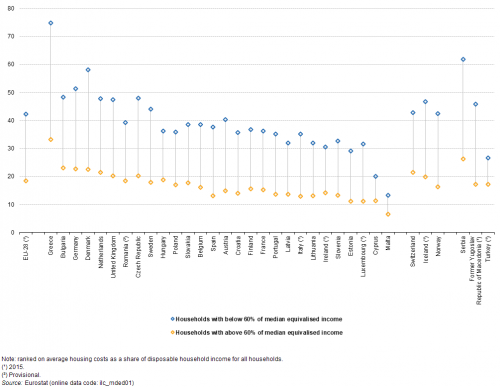
(% share of disposable household income)
Source: Eurostat (ilc_mded01)
Severe housing deprivation
Housing deprivation is a measure of poor amenities: the indicator of housing deprivation shows the proportion of the population living in dwellings with a leaking roof, or no bath/shower, or no indoor toilet, or in dwellings that are considered too dark; this information comes from EU-SILC.
One of the key dimensions in assessing the quality of housing is the availability of sufficient space. Overcrowded dwellings are defined as those households which do not have a minimum number of rooms at their disposal, equal to: one room for the household; one room per couple in the household; one room for each single person aged 18 years and over; one room per pair of single people of the same gender between 12 and 17 years of age; one room for each single person between 12 and 17 years of age and not included in the previous category; one room per pair of children under 12 years of age.
The severe housing deprivation rate is calculated as the percentage of the population that lives in dwellings which are considered to be overcrowded, while also exhibiting at least one of the housing deprivation measures referred to above.
Almost 1 in 20 people across the EU-28 faced severe housing deprivation in 2016 …
The severe housing deprivation rate provides an alternative way of measuring housing pressures. In 2016, according to EU-SILC, severe housing deprivation in the EU-28 touched almost 1 in 20 persons, or 4.8 % of the population. The severe housing deprivation rate peaked at 19.8 % in Romania, while a double-digit rate was also recorded in Hungary, Latvia and Bulgaria. By contrast, less than 2.0 % of the population in Belgium, Germany, Denmark, Spain, Malta, the Netherlands, Cyprus, Ireland and Finland faced severe housing deprivation.
… with a higher risk of severe housing deprivation among those households with dependent children
Housing deprivation in the EU-28 varies considerably according to the type of household that people live in. As Figure 5 shows, the risk of severe housing deprivation rose for each type of household when having dependent children. The lowest severe housing deprivation rates (1.3 %) were recorded for those living in a household composed of two adults without children. The risk of severe housing deprivation was almost three times as high (3.8 %) for those living in a household composed of two adults with two dependent children, rising to more than eight times as high (10.7 %) for those living in a household composed of two adults with three or more children. A relatively small proportion (2.5 %) of people living alone faced severe housing deprivation, although here too the addition of at least one dependent child led to the risk of severe housing deprivation by close to threefold (7.7 %). By contrast, households with the highest risk of severe housing deprivation were characterised by the presence of three or more adults. Some 5.6 % of the EU-28 population that was living in a household with three or more adults and no children faced severe housing deprivation in 2016, a share that rose to 12.9 % among those living in a household composed of three or more adults with dependent children.
While the risk of housing deprivation varied considerably according to household type, there were also considerable disparities between EU Member States: for example, severe housing deprivation rates for those living in a household composed of two adults with three or more children peaked at 58.5 % in Bulgaria, 57.2 % in Romania, 38.0 % in Hungary and 35.6 % in Latvia, while rates for those living in a household composed of a single adult with dependent children peaked at 31.6 % in Hungary, 31.1 % in Romania, 22.0 % in Poland and 20.1 % in Latvia.

(%)
Source: Eurostat (ilc_mdho06a) and (ilc_mdho06b)
In the Baltic Member States, Bulgaria and Romania the share of dwellings without an indoor flushing toilet exceeded 10 % in 2011
As noted above, one of the criteria for severe housing deprivation is the lack of an indoor toilet. The population and housing census provides a similar indicator (to that collected within EU-SILC), with information relating to the proportion of dwellings that were without an indoor flush toilet facility, as presented in Table 4; the census has more detailed information providing for a regional analysis.
In 2011, some 2.7 % of all dwellings in the EU (excluding Croatia and Finland) did not have an indoor flush toilet facility. The proportion of dwellings without an indoor flush toilet was zero in Belgium, Luxembourg, the Netherlands, Sweden and the United Kingdom, rising to just above 10 % in Estonia and close to 20 % in the other two Baltic Member States of Latvia and Lithuania, before peaking at 26.4 % in Bulgaria and 38.1 % in Romania.
There is often a high degree of investment in infrastructure in capital regions (defined here in relation to NUTS level 2 regions) and it is therefore not surprising to find that the proportion of dwellings without an indoor flush toilet facility was generally lower than the national average in these capital regions. This pattern held across most EU Member States, although there were exceptions, as Austria and to a lesser degree Poland both recorded more dwellings without an indoor flush toilet facility in their capital regions. In the Austrian capital region of Wien some 6.0 % of dwellings were without an indoor flush toilet facility, compared with an average of 2.2 % across the whole of Austria.
Table 4 also provides information on those NUTS level 2 regions with the highest proportion of dwellings that did not possess an indoor flush toilet facility. Among the 272 different regions for which data are available, those with the highest proportions were principally located in rural areas (Molise and Alentejo), geographically remote areas (Anatoliki Makedonia, Thraki; the Ciudad Autónoma de Ceuta; Guyane), regions characterised by relatively low standards of living (Severozapaden), or regions in the process of urban regeneration (Chemnitz).
Lack of satisfaction
In 2012, just over one tenth of the EU-28 population was unsatisfied with the dwelling in which they lived
Figure 6 presents information relating to housing satisfaction, derived from EU-SILC. It shows that slightly more than 1 in 10 (10.7 %) persons across the EU-28 had a low or very low level of satisfaction with the dwelling in which they resided in 2012. The information presented confirms that households with children tended to be less satisfied with their home, while those living as a couple without children tended to be the most content.
There were wider divergences when analysing the results by EU Member State, as just 3.6 % of the population in the Netherlands had a low or very low level of satisfaction with their dwelling, while in Denmark the level of discontent was more than seven times as high (26.6 %). The proportion of the population expressing that they had a low or very low level of satisfaction with their dwelling was relatively uniform in most of the EU Member States, irrespective of the household type. Nevertheless, there were some exceptions and these were often linked to the presence of children in the household. For example, in Bulgaria more than a quarter (26.1 %) of the population living in households with dependent children had a low or very low level of satisfaction with their dwelling, compared with 13.0 % of the population living in households without children. Romania, Ireland, France and the United Kingdom were also characterised by relatively high shares of people living in households with dependent children reporting that they had a low or very low level of satisfaction with their dwelling.
In a few cases — the Netherlands, Poland, Slovenia, Croatia, Greece and Portugal — the share of the population expressing a low or very low level of satisfaction with their dwelling was higher among those living in households without children (than those with children). The differences were however generally quite small, the biggest being recorded in Portugal, where 10.9 % of the population living in households without dependent children expressed the view that they had a low or very low level of satisfaction, compared with 9.5 % of those living in households with dependent children.

(% share)
Source: Eurostat (ilc_hcmp04)
Source data for tables and graphs
Direct access to
- All articles from People in the EU: who are we and how do we live?
